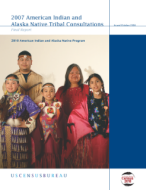2007 American Indian and Alaska Native Tribal Consultations: Final Report
2007 American Indian and Alaska Native Tribal Consultations: Final Report
Executive Summary
In 2007, the U.S. Census Bureau headquarters took steps to improve its ongoing government-to-government relationship with federally recognized American Indian and Alaska Native (AIAN) tribes by conducting 14 consultation meetings with tribal representatives. The objectives of the consultation meetings are listed below.
- Improve two-way communications with tribal officials.
- Create an opportunity for AIAN governments to raise issues and Census Bureau to gain insight into key issues.
- Build partnerships and collaboration on issues of mutual concern.
- Identify issues requiring input and participation.
- Promote innovative methods for further consultation.
- Involve tribes in the decision-making process.
- Build a permanent relationship between tribal governments and the Census Bureau.
This report provides an overview of the consultation meetings, summarizes key issues discussed, and lists recommendations received from tribal delegates.
The term “tribal delegate” is used throughout this report and refers to the tribal leaders and/or their designees who attended any of the 14 tribal consultation meetings. When comments listed come directly from a tribal leader, that reference will be included.
The consultation meeting agenda included five Census Bureau programmatic areas for discussion: (1) Racial Statistics, (2) Geography, (3) 2010 Census Publicity Campaign, (4) Partnership and Data Services, and (5) 2010 Recruiting Program. These Census Bureau programmatic areas created a framework for the consultation meetings, which led to tribal delegates raising the four key issues outlined below.
Classification of Tribes as “Racial Groups” Rather Than as “Sovereign Nations”
A primary issue raised by the tribal delegates is that in the question about race in the decennial census, data on the AIAN population and tribal affiliation are collected using a check box and write-in space, respectively. This creates the perception that federally recognized tribes are racial and not political entities. Tribes are sovereign governments, and the classification of tribes as “racial groups” could be thought to undermine tribal sovereignty and erodes the special relationship that the government has with federally recognized tribes. The tribal delegates recommended adding a new question, separate from the race question, to the 2010 Census questionnaire that asks if a respondent is a member of a federally recognized tribe and to provide the tribe name. Tribal delegates added that the Census Bureau should provide a listing of all the federally recognized tribes with numeric codes to avoid handwriting, spelling, and other errors made when the name of the enrolled or principal tribe is written on the census questionnaire. Thus, the participants recommended that there should be two questions on the census questionnaire, one to count members of federally recognized tribes, and another to count members of the AIAN population.
Accuracy and Limitations of Census Data
Tribal delegates expressed a belief that the AIAN population is seriously undercounted in census data, and many tribal delegates pointed to their enrollment numbers as being the true reflection of their count. The tribal delegates understood that the census count cannot be substituted with tribal enrollment figures. However, several recommended that the Census Bureau identify mechanisms for more complete reporting of an individual’s enrolled tribe, such as the inclusion of a numerical code for each tribe on the tribal enrollment or identification card. This numerical code could then be reported on census questionnaires. Tribal delegates were also concerned about how other agencies use AIAN data. They stated that the Office of Management and Budget’s (OMB) definition of AIAN, which is the guideline that the Census Bureau uses to collect data on race, does not provide useful information for funding, and it undermines tribal sovereignty. They mentioned that the OMB definition of AIAN should not include “cultural groups” or South and Central American Indians, as they do not have a unique political relationship with the federal government. Still, agencies use census data on tribes rather than tribal enrollment numbers. The participants recommended that the Census Bureau should convene an interagency task force to discuss the process for collecting, tabulating, and presenting AIAN data.
Tribes’ Involvement in Decision Making
Another overarching issue identified by tribes was the involvement of tribes in the decennial census decision-making process. Tribal delegates expressed that consultation should happen in the early planning stages to ensure that tribal input is considered in all decisions. They also recommended that future consultations include all agencies relevant to the decennial census process, including OMB.
Communicating the Value of the Census to Tribes
Tribal delegates explained the importance of identifying and communicating the value of the census to tribes, as there are benefits previously communicated that are no longer effective. The historical benefits (e.g., economic, planning, reapportionment) may no longer be effective methods for encouraging participation. For example, some tribes that have prospered by gaming and other economic ventures may not be as dependent on federal funding. If so, the message that census data will help them receive a more equitable allocation of federal funding may not be seen as a benefit. Tribal delegates recommended that the Census Bureau conduct effective partnership, marketing, and promotional activities to maximize participation in the 2010 Census.
While tribal delegates identified various issues and concerns, most were appreciative of the Census Bureau’s efforts to include them in the 2010 Census process. They encouraged the Census Bureau to continue the positive momentum gained from these consultations. They were also pleased to learn that each Census Bureau regional office plans to meet individually with the tribes in their region. Where feasible, tribes want the Census Bureau to use the information learned at the consultations for the 2010 Census process. If the input provided by tribes cannot be included in the 2010 Census process, then tribes encouraged the Census Bureau to incorporate their recommendations during the planning process for the census in 2020.





